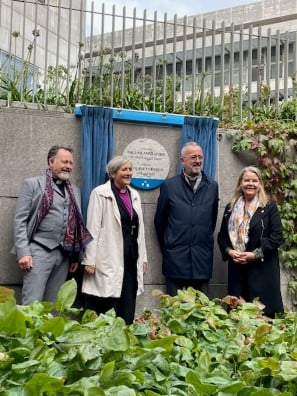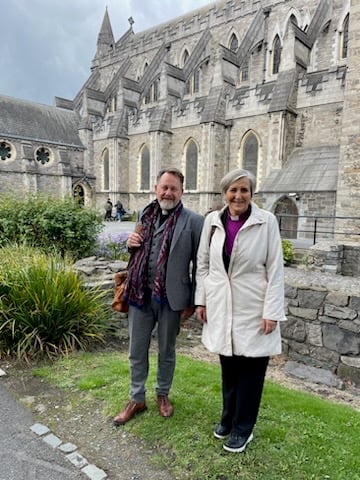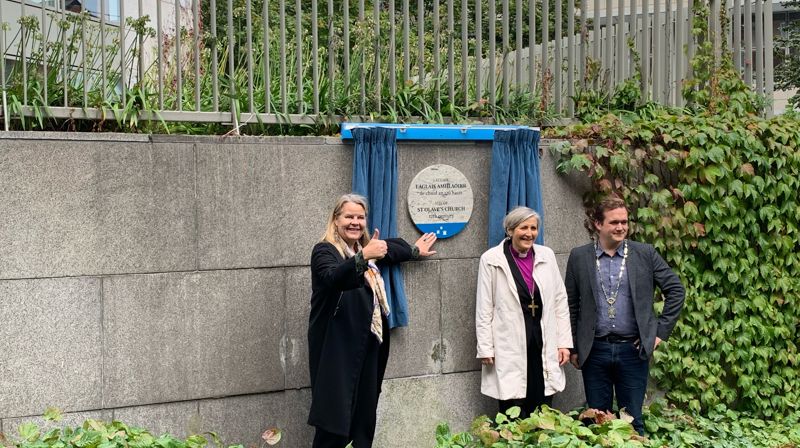I Fishamble street i dagens Dublin lå St.Olaves church, som på 1100-tallet var plassert midt i, det som en gang var, vikingbyen. Olav den hellige er Norges vernehlegen, og steder med spor etter ham finnes over hele Europa og de stedene hvor vikingene dro.
Minneplakett
Ideen til minneplaketten kom i fra tidligere ambassadør til Irland, Else Berit Eikeland. Nåværende ambassadør, Mari Skåre, sa under avdukingen at minneplaketten er et symbol på sterke bånd og felles historie.
- Minneplaketten ved stedet hvor olavskirken lå er i utvidet forstand et vitnemål om de tette båndene og den felles historien Norge og Irland deler, fra de første nordmennen gikk i land og helt frem til i dag. Havet førte oss sammen den gang og vil fortsette å gjøre det i fremtiden.

Pilegrimsprest Einar Vegge, Biskop Herborg Finnset, domprost i Christchurch Dermot Dunne, Norges ambassadør til Irland Mari Skaare.
Avduking
Minneplaketten ble avduket av en representant fra ordførerens kontor i Dublin, Michael Pidgeon.
- Jeg er svært glad for å se Dublins historiske forbindelser til Norge minnet på denne måten, på et sted hvor folk i Dublin for hundrevis av år siden kom for å be, feire, døpe sine barn og sørge over sine døde, sa han under avdukingen.

Biskop Herborgs tale
Biskop i Nidaros, Herborg Finnset og pilegrimsprest, Einar Vegge deltok begge i feiringen og avdukingen av minneplaketten. Biskopen holdt en tale, og her kan du lese den.
Most honourable audience, City Mayor, Your Excellency, councellors, everyone:
It’s a pleasure to be here with you! Thank you for a warm welcome to Dublin and for the opportunity to take part in the unveiling of this plaque here, on the place where the old St Olave church once was.
The historical links and contacts between Norway and Dublin are many, but somehow hidden in the modern Dublin.
The old norse history across the North Sea and beyond in the North Atlantic is still a source for connecting people and culture, in a common heritage.
This is why this small plaque is important to me as the Bishop of Nidaros, in Trondheim, from the city where Saint Olav was canonized a year after his death. Nidaros Cathedral, the national shrine of Norway and the biggest medieval cathedral in the Nordic countries, was built as a shrine for pilgrimage to the grave and shrine of Saint Olav.
Olav was a king with a Viking mindset from his time, in the more than century-long period of transition from the old faith into the Christian view on humanity, justice and destiny, into the Christian faith. After all: He was the king who introduced new, Christian laws.
Olav Haraldsson, later known as Saint Olav, was the King of Norway from 1015 to 1028. He died at the battle of Stiklestad 29 July 1030, in an attempt to seize the power in Norway again.
Circumstances and the king’s attitude and new orientation in the returning attempt, and finally his death, was the foundation of the stories that made the sanctification.
His sainthood encouraged the widespread adoption of Christianity in Norway. And during the times of foreign rule of Norway, Saint Olav became a symbol of Norwegian independence and pride. Today there is a revival of pilgrimage as a way to connect both with nature and Christian traditions - from new perspectives, also influenced from the spirituality of the islands in the West.
Saint Olav became the saint of Norse seamen and traders. The veneration of St Olav spread rapidly in Northern Europe, and the old Norse area of influence in the Northern and Western sea areas. Churches and chapels were, and are dedicated to him from Novgorod in the east (today’s Russia) to here in Dublin in the west.
The Viking, and later the Norse period was not only about raiding, but also about trade, continuous inhabitation and new cultural links. The earliest Christian influence most probably came to Norway from Ireland. Already in the 9th century we find many standing crosses in the south-western part of Norway, with a clear influence from the west.
There was a strong integration of the Norse with the Irish. The excavations here in Dublin have many examples of this. This Saint Olav church in the middle of Viking Dublin was established by the Foreign-Gael or Norse-Irish, and was an example of the close links to their homeland Norway.
As the Bishop of Nidaros I will bring with me the memory of this small parish Saint Olav church here in Dublin back to Trondheim. With this plaque the church will not be forgotten. Let me end by thanking you all for the friendship and support for our joint history.

